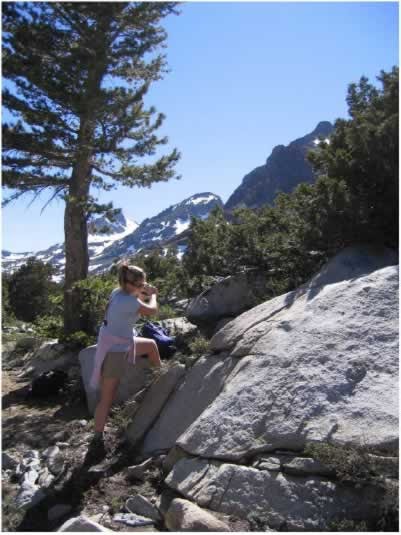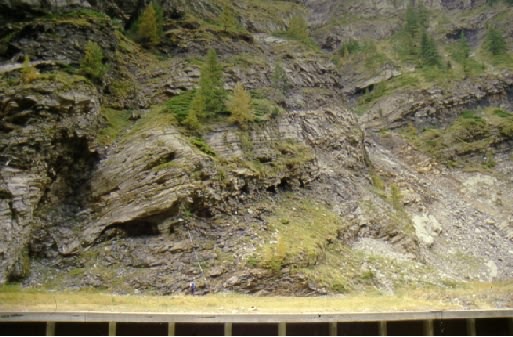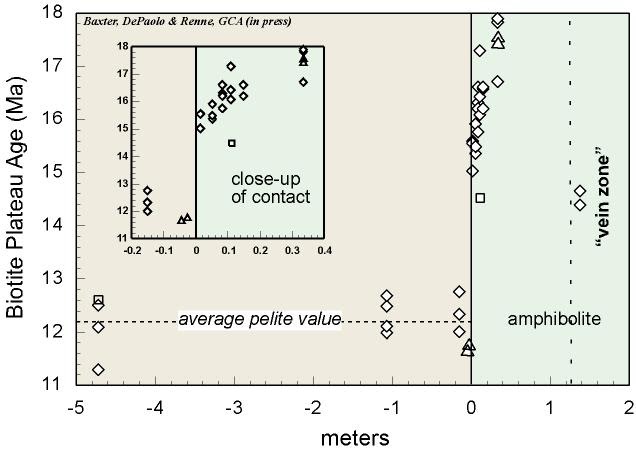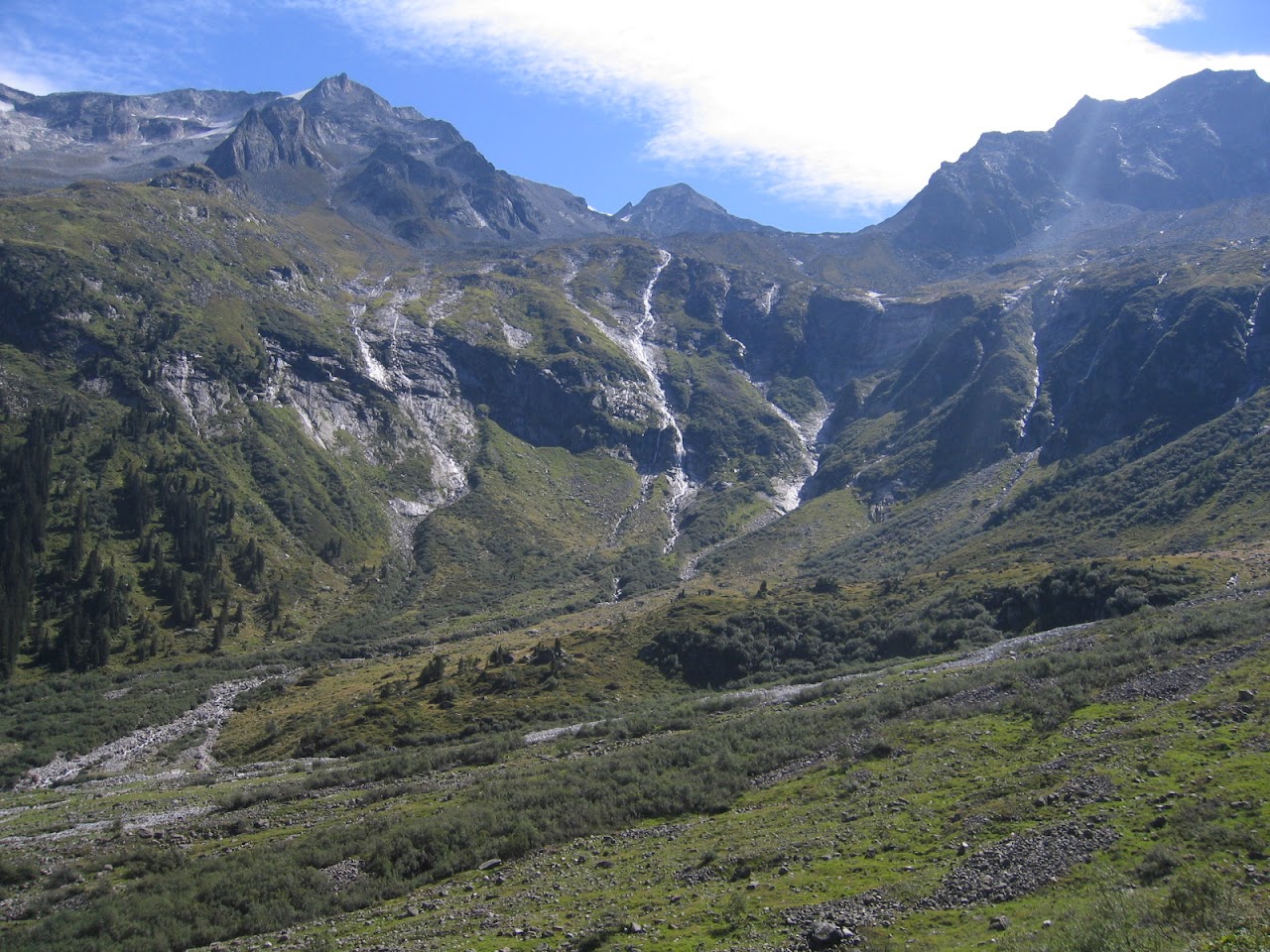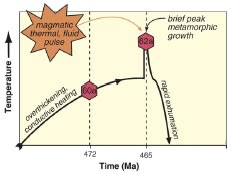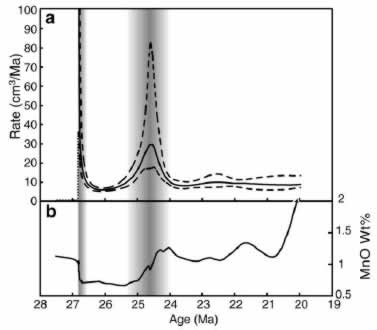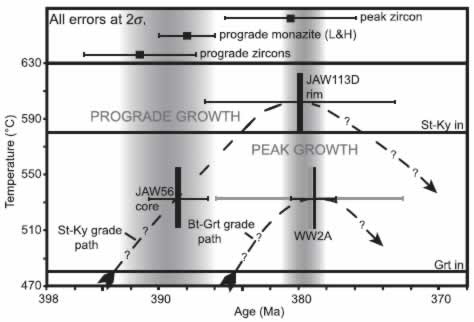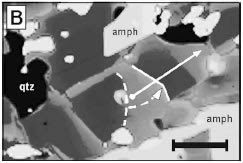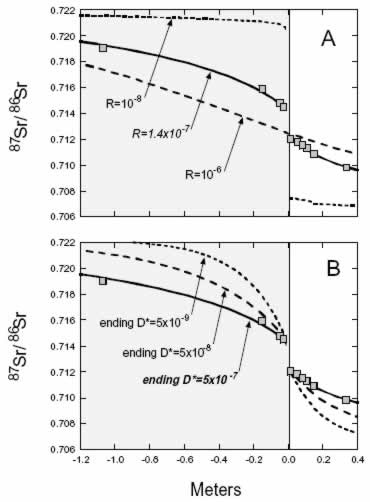Research
By studying the vast geological record, in my research group we interpret the chemistry of diverse Earth materials (rocks, minerals, sediments, salts, and more) to elucidate the timescales, rates, and mechanisms of broad geological processes (tectonics, metamorphism, subduction, global geochemical cycles, lithosphere-hydrosphere-atmosphere interactions). An interest in unraveling the history of the Earth, as well as predicting certain aspects of its future, is at the heart of much of the research going on in my group.
Much of the research in the group involves the new TIMS Facility where we are pushing the limits of temporal and spatial resolution in isotopic analysis.
Analysis of carefully collected natural samples provides a crucial field context for research. That fundamental link to natural systems is a key aspect of research going on in my group and has taken us to such field areas as the Greek Isles, Austria, Switzerland, Scotland, California, New England, and more.
If you are interested in discussing any of these existing, or potential new research areas, please feel free to contact me.
Research Areas
**Download Ethan Baxter's "Garnet: Tree Rings of Crustal Processes" powerpoint here
Garnets contain the "tree-rings" of tectonic and metamorphic processes. Each garnet crystal is a history book spanning potentially millions of years waiting to be read and interpreted - the bigger the garnet, the longer the history. In this way, garnets contain otherwise inaccessible information about evolving prograde metamorphic conditions, processes, and their driving forces. We have developed integrated methodologies to chemically map, microsample, and date the growth of zoned garnets using the Sm-Nd isotopic system. New TIMS analytical developments permit precise measurement of very small quantities of Neodymium (Nd) isotopes permitting high resolution geochronology on multiple concentric growth zones within single garnet crystals. Individual age precision better than ±1 million years is now usually achieved. See our recent paper that describes the details of our microsampling and Sm-Nd geochronologic methods.
We are also pushing the limits on sample size and precision even further in developing the geochronology of detrital garnet grains in the ancient sedimentary (and metasedimentary) record. Detrital garnet geochronology would help inform us of the rates and conditions of the planet’s very first tectonic and metamorphic activity, as well as regional patterns of prograde metamorphic timing in more recent orogens.
If you are interested in potential collaborative research involving garnet geochronology in the BU TIMS Facility, please contact me directly.
- NSF Grant EAR-1250497 "Collaborative Research: Field-Based Quantification of Dehydration Flux from Subducting Lithologies, Syros and Sifnos, Greece", 1/1/13, PI: Baxter; Co-PIs: Caddick
- NSF Grant EAR-1049350 “Detrital Garnet Sm/Nd Geochronology: A New Window into Earth's Tectonic Past”, 9/1/10; PI: Baxter
- NSF Grant EAR-0948308 “Collaborative Research: Testing for Rapid Pulses of Crustal-scale Heat and Mass Transfer by Fluids in Metamorphic "Hot Spots", New Hampshire, USA”, 8/1/10, PI: Ague; Co-PIs: Baxter, Chamberlain
- NSF Grant EAR-0911582 “Collaborative Research: Developing a Practical and Quantitative Method for Measurement of Metamorphic Porphyroblast Crystallization Kinetics and Strain Rate”, 7/1/09, PI: Hirsch; Co-PIs: Stowell, Baxter
- NSF Grant EAR-0547999 “CAREER: Rates and Timescales of Metamorphic Reactions at Convergent Plate Boundaries”, 1/1/06, PI: Baxter
- NSF Grant EAR-0521266 “Acquisition and Development of a Thermal Ionization Mass Spectrometer Facility at Boston University”, 9/15/05, PI: Baxter; Co-PIs: Kurtz, Plank, Murray
- Dragovic B, Samanta LM, Baxter EF, Selverstone J, 2012. Using Garnet to Constrain the Duration and Rate of Water-Releasing Metamorphic Reactions During Subduction: An Example from Sifnos, Greece. Chemical Geology, v. 314-317. p. 9-22. (link to paper)
- Pollington AD and Baxter EF, 2011. High precision microsampling and preparation of zoned garnet porphyroblasts for Sm-Nd geochronology. Chemical Geology, 281, 270-282. (PDF)
- Pollington AD and Baxter EF, 2010. High resolution Sm/Nd garnet geochronology reveals the uneven pace of tectonometamorphic processes. EPSL, 293, 63-71. PDF
- Peterman EM, Hacker BR, and Baxter EF, 2009. Phase transformations of continental crust during subduction and exhumation: Western Gneiss Region, Norway. Eur J Mineral, 21, 1097-1118. PDF
- Harvey J and Baxter EF, 2009. An improved method for TIMS high precision neodymium isotope analysis of very small aliquots (1 – 10 ng). Chem Geol, 258, 251-257. PDF
- Lancaster PJ, Baxter EF, Ague JJ, Breeding CM, and Owens TL, 2008. Synchronous peak Barrovian metamorphism driven by syn-orogenic magmatism and fluid flow in southern Connecticut, USA. J Met Geol, 26, 527-538. PDF
- Baxter EF, Ague JJ, and DePaolo DJ, 2002. Prograde Temperature-Time Evolution in the Barrovian Type-Locality Constrained by Precise Sm/Nd Garnet Ages from Glen Clova, Scotland. J Geol Soc Lond, 159, 71-82. PDF
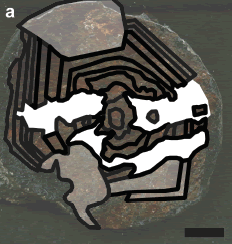
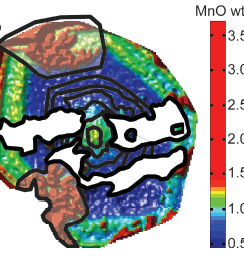
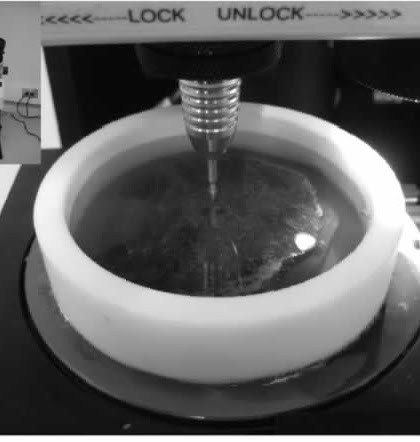
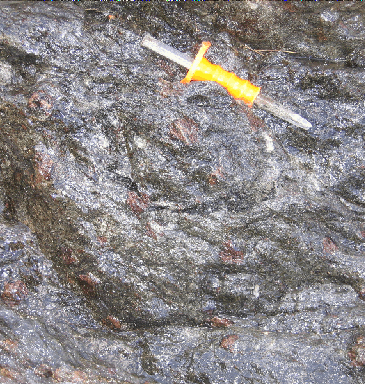
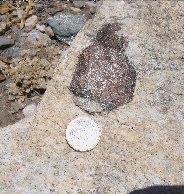
The solid earth plays a major role in the long-term geologic carbon cycle. Atmospheric, oceanic, and mantle derived CO2 or CO2-rich fluids reacts with silicate minerals and/or dissolved cations in the lithosphere to form secondary carbonate minerals in a variety of geological environments (regional metamorphism, contact metamorphism, subduction zone metamorphism, hydrothermal and ore-forming systems in the continental and oceanic crust, sedimentary basins, and weathering). In order to interrogate and quantify matters of rate, timing, and flux of CO2 (and hydrothermal fluid flow in general) within the lithosphere over geologic (i.e. >1 Myrs) timescales, we seek to develop an accurate and precise carbonate geochronometer.
Carbonate geochronology has proven to be a significant challenge due to natural complexities and analytical limitations. Our developmental emphasis will be on the less-frequently tested Sm/Nd system for carbonates, and on the subsequent integration and cross-checking of Sm/Nd and U/Pb data. Preliminary data show that carbonate minerals datable by Sm/Nd do exist, though the context and identity of the datable mineral’s occurrence is not clear.
- NSF Grant EAR-1019845 “Collaborative Research: Geochronology of Carbonate Mineralization in the Lithosphere”, 9/1/10, PI: Baxter; Co-PI: Maher
- Henjes-Kunst, F., Prochaska,W., Niedermayr, A., Sullivan, N., Baxter, E. 2014. Sm-Nd dating of hydrothermal carbonate formation: the case of the Breitenau magnesite deposit (Styria, Austria). Chemical Geology, 387, p. 184-201 (PDF)
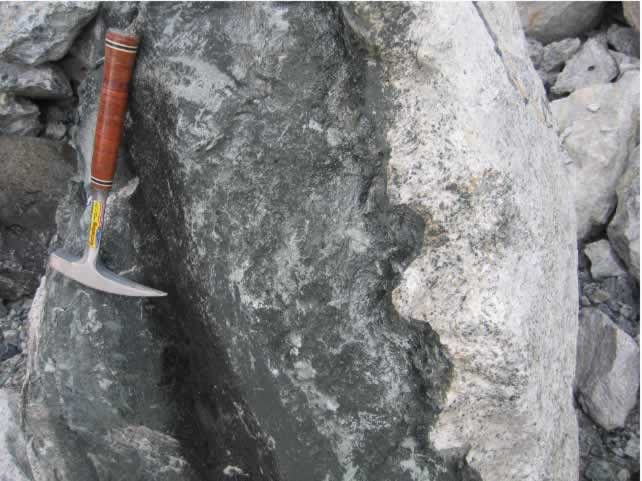
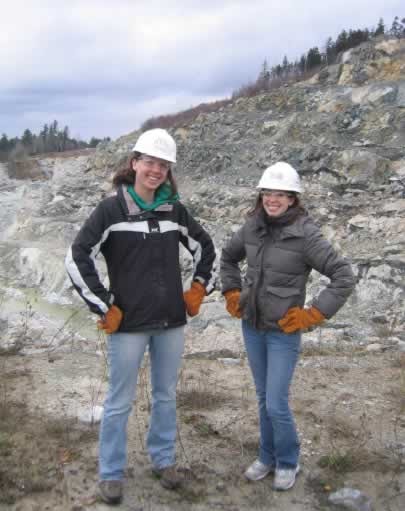
Plate boundary processes involve the production, consumption, and transport of fluids, as well as the evolving physical properties of the solid earth. Metamorphic reactions are at the roots of these processes. Model predictions of subduction zone phenomena (including devolatilization, magma genesis, and eclogitization) and regional orogeny require some quantification of the rate and timescale over which metamorphic reactions in the crust and mantle proceed.
Garnet frequently grows during dehydration, thus preserving a record of these reactions during metamorphism. In this research, we are integrating high precision zoned garnet geochronology with thermodynamic analysis of garnet forming dehydration reactions to directly measure dehydration fluxes in subduction zones and regional orogeny. Ongoing research has focused on well preserved garnet-bearing blueschists on the islands of Sifnos and Syros, Greece as well as large rotated garnets from Townshend Dam, Vermont.
- NSF Grant EAR-1250497 "Collaborative Research: Field-Based Quantification of Dehyration Flux from Subducting Lithologies, Syros and Sifnos, Greece", 1/1/13, PI: Baxter; Co-PIs: Caddick
- NSF Grant EAR-0911582 “Collaborative Research: Developing a Practical and Quantitative Method for Measurement of Metamorphic Porphyroblast Crystallization Kinetics and Strain Rate”, 7/1/09, PI: Hirsch; Co-PIs: Stowell, Baxter
- NSF Grant EAR-0547999 “CAREER: Rates and Timescales of Metamorphic Reactions at Convergent Plate Boundaries”, 1/1/06, PI: Baxter
- Baxter EF, Caddick MJ, 2013. Garnet as a proxy for progressive subduction zone dehydration. Geology, v.41, p. 643-646 (PDF)
- Dragovic B, Samanta LM, Baxter EF, Selverstone J, 2012. Using Garnet to Constrain the Duration and Rate of Water-Releasing Metamorphic Reactions During Subduction: An Example from Sifnos, Greece. Chemical Geology, v. 314-317. p. 9-22. (link to paper)





The noble gases, in particular radiogenic Ar-40 and He-4, have been used within the context of geo- and thermo-chronology for decades with applications to planetary, igneous, metamorphic, tectonic and Earth surface processes. Like any geochronometer, the well developed K-Ar (or Ar-Ar) and U/Th-He geochronometers rest upon several key assumptions and tenets that do not always hold true, and in any case must constantly be evaluated and justified. It has been shown, for example, that the rate and mechanisms governing the transport of noble gases within rocks and minerals, as well as the equilibrium partitioning of noble gases between minerals and fluids in geologic systems, controls the accumulation of radiogenic noble gases, and thus the apparent age recorded. "Excess argon" results when rock scale argon diffusion is too slow for it to escape, or, when argon is partitioned strongly into minerals we might wish to date.
In field based, experimental, and theoretical research, my students, collaborators, and I have sought to quantify and model these effects on geo- and thermo-chronology. Apparent biotite Ar/Ar ages were found to be spatially and lithologically correlated in an outcrop of interlayed pelite and amphibolite in Switzerland. This observation has led to a general model for excess argon in slowly cooling systems (see corrected governing equation in Baxter 2003). Partitioning of argon and helium in grain boundaries has been shown to be quite significant in nominally dry systems. We have also recognized complex multiple diffusion pathways for argon in both quartz and feldspar by means of high resolution depth profiling analysis of "in-diffusion" experimental samples. All of this information helps us refine our understanding noble gas behavior and its geochronologic significance.
- NSF Grant EAR-0337527 “Partitioning of Noble Gases Between Crustal Minerals: Implications for
- Geochronology", 3/1/2004, PI: Baxter
- Baxter EF 2010. Diffusion of Noble Gases in Minerals. Reviews in Mineralogy & Geochemistry, 72, Ch. 11, p. 509-557. (link to GSW)
- Clay PL, Baxter EF, Kelley SP, Watson EB, Thomas J, Cherniak DP, 2010. Combined RBS and laser depth profiling of Ar diffusion in quartz: evidence for two diffusion pathways. GCA, 74, 5906–5925. PDF
- Watson EB and Baxter EF, 2007. Frontiers: Diffusion in solid-Earth systems. EPSL, 253, 307-327. PDF
- Baxter EF, Asimow PD and Farley KA, 2007. Grain boundary partitioning of Ar and He. GCA, 71, 424-451. PDF
- Baxter EF, 2003. Quantification of the factors controlling the presence of excess 40Ar and 4He. EPSL, 216, 619-634. PDF
- Baxter EF, DePaolo DJ and Renne PR, 2002. Spatially Correlated Anomalous 40Ar/39Ar “Age” Variations About a Lithologic Contact near Simplon Pass, Switzerland: A Mechanistic Explanation for Excess Ar. GCA, 66, 1067-1083. PDF


